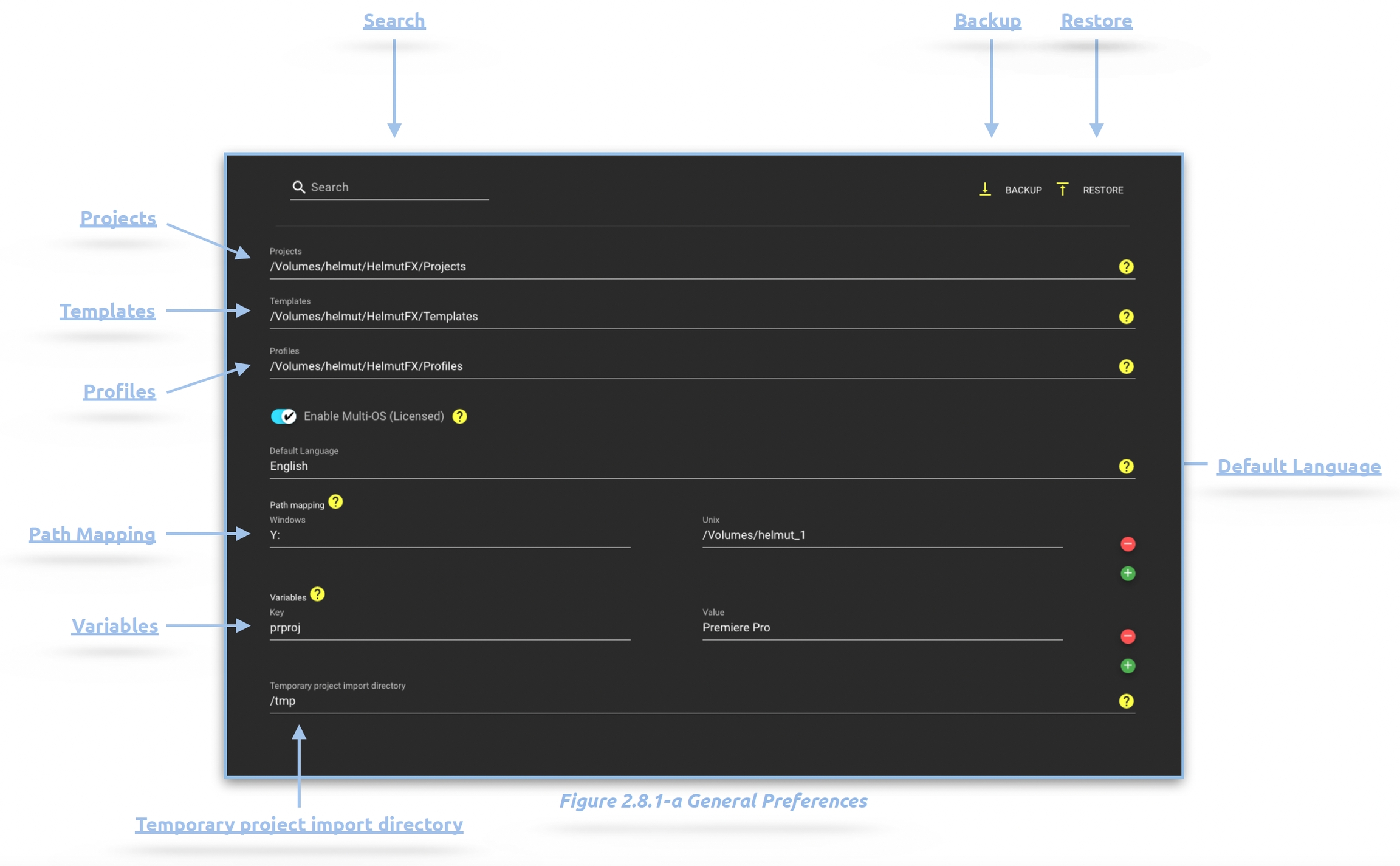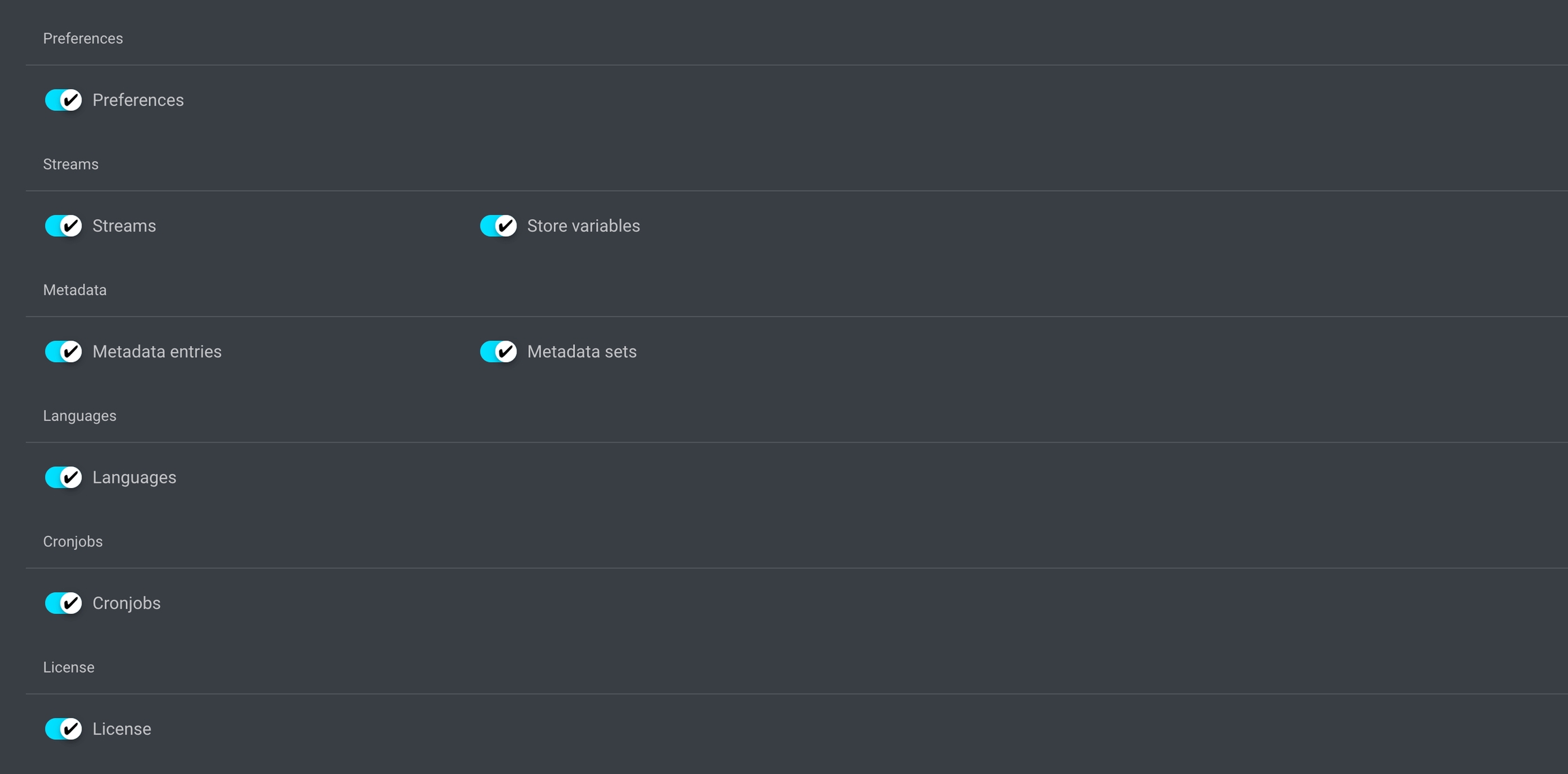Preferences
Overview
The preferences serve as the core of Helmut4. Acting as the central control hub for all communication and translation activities between clients and the server, as well as third-party modules like Active Directory, Elements, CatDV, etc., this is the designated area for their configuration.
Within the preferences, numerous tools, such as backup and restore functionalities, along with Helmut Variables, can be accessed. Additionally, the crucial component is the path mappings, which facilitate the conversion of paths between Windows (UNC) and Unix (Macintosh, Linux) systems.

Setting preferences
Helmut4 Paths
In Helmut4, three essential paths (projects, templates, and profiles) play a crucial role in FX, serving for new projects, user profiles, and templates. Additionally, three other paths are designed specifically for handling imported projects in FX and for uploading or ingesting assets in Cosmo.
The primary paths can be easily accessed through dedicated wildcards:
Projects - {helmut.projects}
Templates - {helmut.templates}
Profiles - {helmut.profiles}
Projects
This is the default path for storing new projects. This path will be resolved in streams when using the {helmut.projects} wildcard. The prerequisite for the entered path is that both the server and all clients can access it. The path must be mounted on the server side in the Docker container. Refer to the server documentation for additional information on how to mount a network share in the Docker environment.
Utilizing the projects path is not mandatory; the project path can be set individually within a Create_Project stream.
Templates
This is the default path for storing project templates and acts as the source when creating a new project from this template. This path will be resolved in streams when using the {helmut.templates} wildcard. The path must be mounted on the server side in the Docker container. Refer to the server documentation for additional information on how to mount a network share in the Docker environment.
Profiles
This is the default path for the master profile which will be used whenever a new user will be created or imported. This path will be resolved in streams when using the {helmut.profiles} wildcard. The path must be mounted on the server side in the Docker container. Refer to the server documentation for additional information on how to mount a network share in the Docker environment.
Temporary project import directory
When a project is imported through the 'Add Project' dialog, the corresponding project file is initially uploaded to a temporary destination path specified in this field. This destination is established before any further processing takes place. The dedicated 'Import_Project' trigger will then utilize this project in its workflow.
The directory path can include wildcards.
Backup and Restore

An alternative cron-based backup and restore solution can be configured using the mongobackup container. For further details, refer to the Define mongodb_backup volume section.
Backup
Clicking on "Backup" opens a dialog that enables you to create an individual backup of all relevant preferences and configurations. These can be backed up either individually, in groups, or all at once for comprehensive backup.
Within the dialog, users can select specific information to include in the backup using toggle switches. The backup is then saved as a .zip file on your local computer.
The following components of the system are available for backup:


If you are unsure which options should be backed up, consider sticking with the "toggle all" option.
Restore
Clicking on "Restore" opens a dialog that enables you to upload a .zip file from a previous backup. A message will appear, asking you to confirm whether the backup should overwrite all existing data. You can either accept or abort this action.
Default Language
Clicking the dropdown menu enables you to select a language that has been created previously in the Languages window. This setting will apply globally to all users.
Using Helmut in a multilingual mode is not possible.

Path Mapping
In the path mapping table, you have the option to define system-wide paths for translating between UNC and UNIX paths. To add new paths, click the "+" button located on the right edge under path mapping.
In the left Windows column, you can specify either a UNIX path (preferred) or a Drive letter path. In the right Unix column, define its UNIX equivalent.
These paths facilitate the seamless conversion of paths between Windows and Macintosh/Linux in an automated manner.

For example:
UNIX: /Volumes/arturo_1/folder1/folder
UNC (resolved): \\EFS-192.168.122.118\arturo_1\folder1\folder2
UNC: L:\folder3\folder4
UNIX (resolved): /Volumes/helmutcloud/folder3/folder4
The following wildcards can be employed to translate a path according to the specific host system:
Helmut Variables
Please refer to Helmut Variables fur further information.
Job Database Cleanup
Please refer to Job Database Cleanup fur further information.
Encrypted Variables
Please refer to Encrypted Variables fur further information.
Modules
Please refer to Modules fur further information.
Last updated